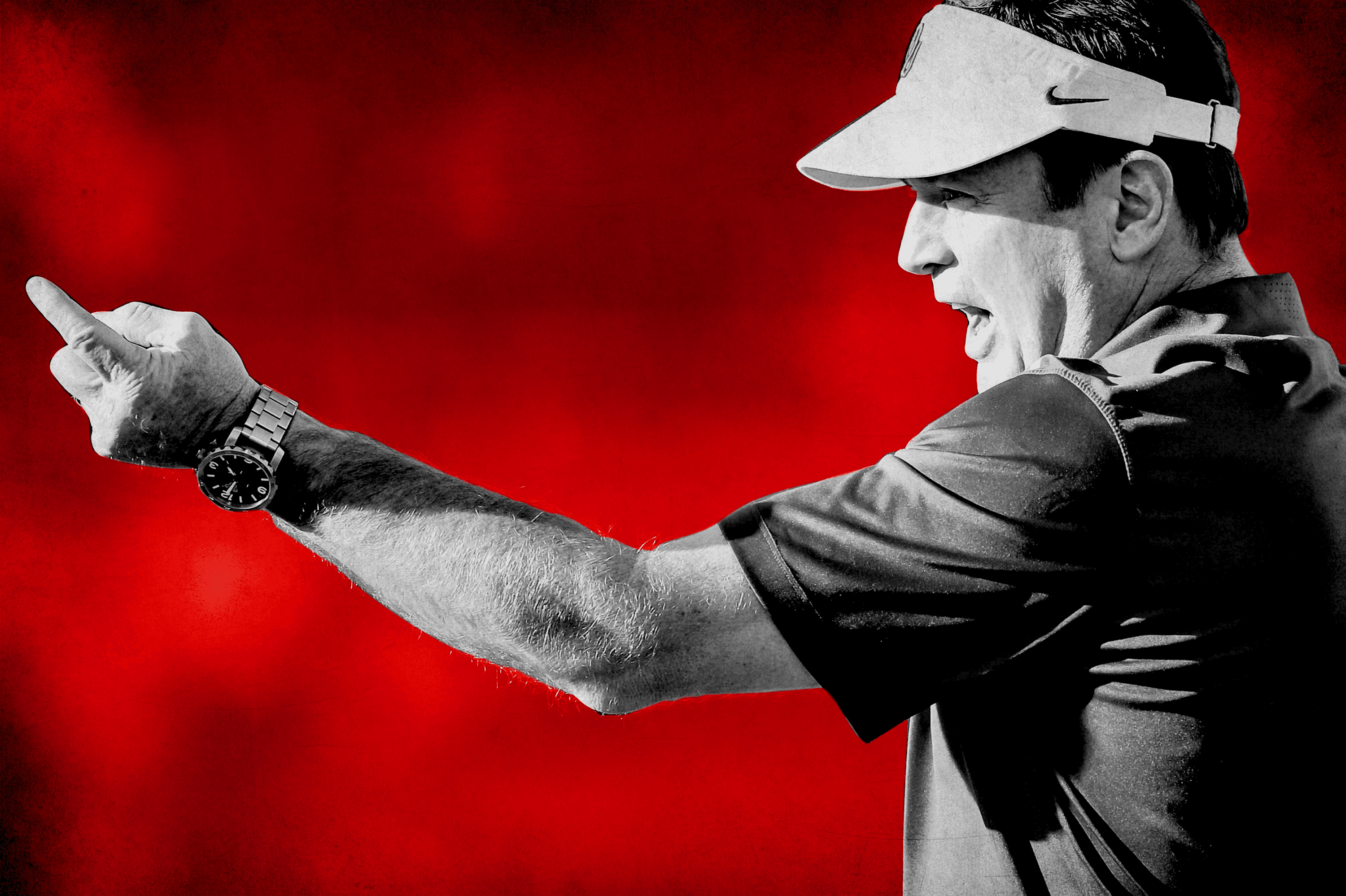Red River Recruiting
After dominating Texas and the rest of the Big 12 on signing day, Oklahoma is poised for a playoff leap
Conference parity in the age of the College Football Playoff is a double-edged sword. More competitive teams boost a league’s standing and late-season drama, of course, but too many of these teams can lead a conference to self-cannibalize, preventing any one standout from being considered for the final four.
Which is why this year’s recruiting cycle delivered both good and bad news for the Big 12: The conference that previously added a title game to raise its collective playoff odds may now see a path develop organically as well. Thanks to the combination of Oklahoma’s own successes — which yielded Rivals’ no. 7 recruiting class nationally — and the dismal hauls of its Big 12 brethren, no team did a better job improving its chance at upcoming playoffs than the Sooners.
On National Signing Day, Baylor added depth but few elite prospects, with Matt Rhule’s team notching fewer four-star players than Rutgers or Illinois. West Virginia assembled its worst-ranked class since joining the Big 12. TCU tumbled from 20th last year to 41st this year. And Texas — well, new coach Tom Herman compared the Longhorns’ recruiting to Iowa State’s, so UT fans are probably feeling more burnt than orange right about now.
All the while, Oklahoma coach Bob Stoops gobbled up blue-chippers like the star of a Doritos commercial. The Sooners’ total of 18 four-star recruits is their highest in the Rivals era (since 2003), while their 67-percent blue-chip signees mark (those with four- or five-star ratings) is their highest since 2008.
Highlights from this year’s class include a pair of top-100 receivers in Cedarian Lamb and Charleston Rambo, top-250 running backs in Trey Sermon and Kennedy Brooks, and a robust defensive-backs class led by Justin Broiles. From their Sugar Bowl–winning squad, the Sooners return quarterback Baker Mayfield (fresh off setting the all-time NCAA record for passing efficiency) and all five starting offensive linemen, but they lose 74 percent of their all-purpose yardage to graduation and the draft. The addition of skill position athletes and defensive backs in the pass-happy Big 12 should plug a number of holes in Oklahoma’s roster.
Beyond addressing its own needs, Oklahoma stands to benefit just as much from what its conference rivals failed to accomplish, as the Sooners recruited almost as many four- and five-star players as the rest of the Big 12 combined. In the other Power Five conferences, no other team came close to that level of supremacy this year.

Rivals assigns points to each school for the quality of its top 20 commits, and in the last five years, the gap between the first- and second-ranked classes in a power conference has never been bigger than the one between Oklahoma and Texas, the no. 2 team in the Big 12 and no. 31 nationally, this year. (Rivals changed its points formula for the 2013 class, so we can only compare like data since then. Still, that encompasses a decent range, with five years and five conferences to look through.)
But that’s just the difference between Oklahoma and second place. To compare Oklahoma to the rest of the Big 12, we can use Z-scores, which measure a particular number’s relative strength by accounting for both the average and range of the entire field of values. By this metric, Oklahoma has the second-most dominant recruiting class (compared to the rest of its conference) of any Power Five team since 2013, with a Rivals point total that’s 2.79 standard deviations better than the average Big 12 mark.
Only Ohio State’s 2014 class is more impressive, at 2.91 standard deviations better than the average Big Ten class that year. The Sooners would salivate at the chance for their current crop of recruits to turn out the same as those Buckeyes, who have won more than 90 percent of their games — second in the country only to Alabama since they matriculated — and who captured the national championship in their freshman season.
Ohio State stood out in 2014 for reasons familiar to 2017 Oklahoma: a dynamic class of prospects — headlined by the likes of Raekwon McMillan and Curtis Samuel — and a down year for its greatest rival, as Michigan stumbled to a coincidental 31st place in the national recruiting rankings.
Similarly, Oklahoma’s predominance is wedded to Texas’s decline; as Oklahoma secured its best class since the Big 12 actually had 12 teams, Texas was staggering to the finish off its worst recruiting period since Rivals started tracking such data. Nationally, this year’s Longhorns sit behind basketball schools Utah, Kentucky, and North Carolina; every non–Big 12 Power Five conference placed at least five teams in front of Texas.
That’s only sweeter music to Oklahoma’s theater-loving ears. As Texas uncharacteristically struggled to capture its top in-state prospects, Oklahoma poached blue-chippers from across the Red River. This year, the Longhorns attracted only three of the Lone Star State’s top 35 recruits compared to Oklahoma’s seven; a decade ago, they picked up 17 of the state’s top 35, versus the Sooners’ two.
Stoops’s ability to carve out a swath of Texas’s home turf is especially important given the talent distribution between the two bordering states. The last five-star prospect to come out of Oklahoma was Gerald McCoy in 2006; since then, Texas, the richest recruiting state in the country, has produced 36 five-stars.
Think about the two programs’ divergent paths from a recruit’s perspective. Since concluding the 2009 season with a BCS Championship Game loss, Texas has four seven-loss records to just three winning ones and doesn’t have a single season with double-digit wins. That means the average recruit this year would have been in elementary school the last time Texas was a power on the field. It follows that Oklahoma would be able to overcome the geographic advantage the Longhorns enjoy.
Five of Oklahoma’s blue-chip pickups from Texas were on offense — including both Lamb and Rambo for Mayfield to throw to this season, and a quarterback, Chris Robison, for the post-Mayfield future. At Oklahoma, Robison could look to Landry Jones and Mayfield as recent examples of successful passers. At Texas, though, the following quarterbacks have led the Longhorns in passing since Colt McCoy left: Garrett Gilbert, David Ash, Case McCoy, Tyrone Swoopes, Jerrod Heard, and Shane Buechele. Besides maybe the freshman Buechele, there’s not a single impressive name or NFL draft pick among that crop.
The possibility of future draft capital is a priority for many top recruits weighing scholarship offers, and Oklahoma has bested Texas in this area, too. Since 2011, Oklahoma has produced twice as many draft picks as Texas (32 to 16), and while Oklahoma’s picks are split evenly between offensive and defensive players, Texas’s are skewed such that its only offensive picks over that span are receiver Marquise Goodwin (third round, 2013) and tight end Geoff Swaim (seventh, 2015). That’s as many as from FCS school Abilene Christian and UAB, which didn’t have a football team the last three seasons.
Herman is a coaching whiz, but until he reestablishes Austin as a point-scoring hotspot, there’s no reason for the best offensive players to prefer Texas for on-field reasons. As the new coach said on signing day, Texas can’t just "go pick guys anymore. We have to fight, claw, scratch, and battle with teams."
A mediocre or worse showing from its flagship program is bad news in general for the Big 12, but until Texas can rebound, the next-best thing is for Oklahoma to take advantage. As SB Nation’s Bud Elliott wrote before the 2016–17 season, the "consolidation of talent at the top changes the dynamics in the league … That’s a big deal for a league desperate to field an elite team, as opposed to several very good ones."
Among the Power Five, the Big 12 is the only conference not to have made a national title game in the playoff era, and while each of the other leagues has seen teams selected to the semifinals at least twice, the Big 12 has had just one lonely representative in three playoff years. Oklahoma’s quest to fill that gap began the moment Mayfield declared that he was staying in Norman for his senior season; and with their talent edge now assured following a nearly unprecedented recruiting haul, the Sooners have taken the next step.

